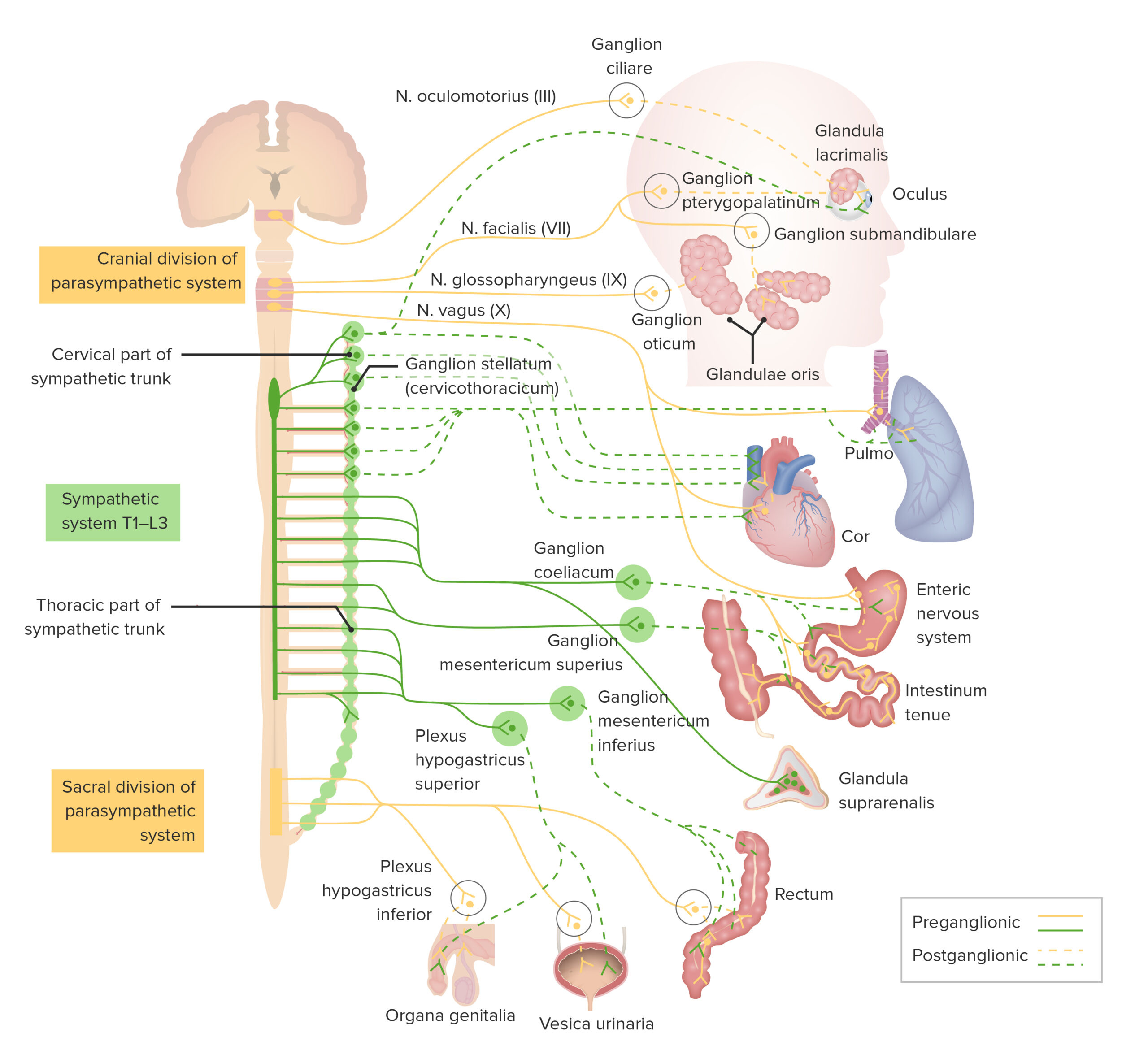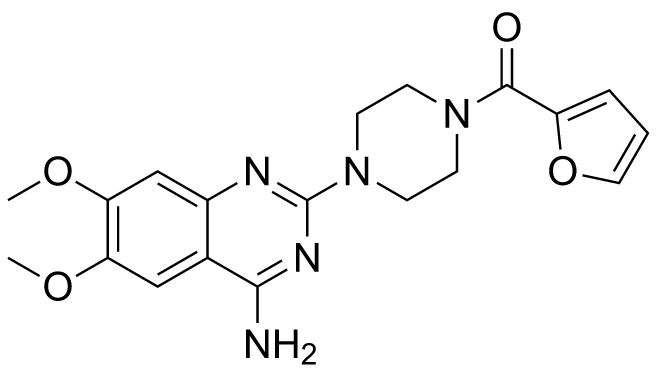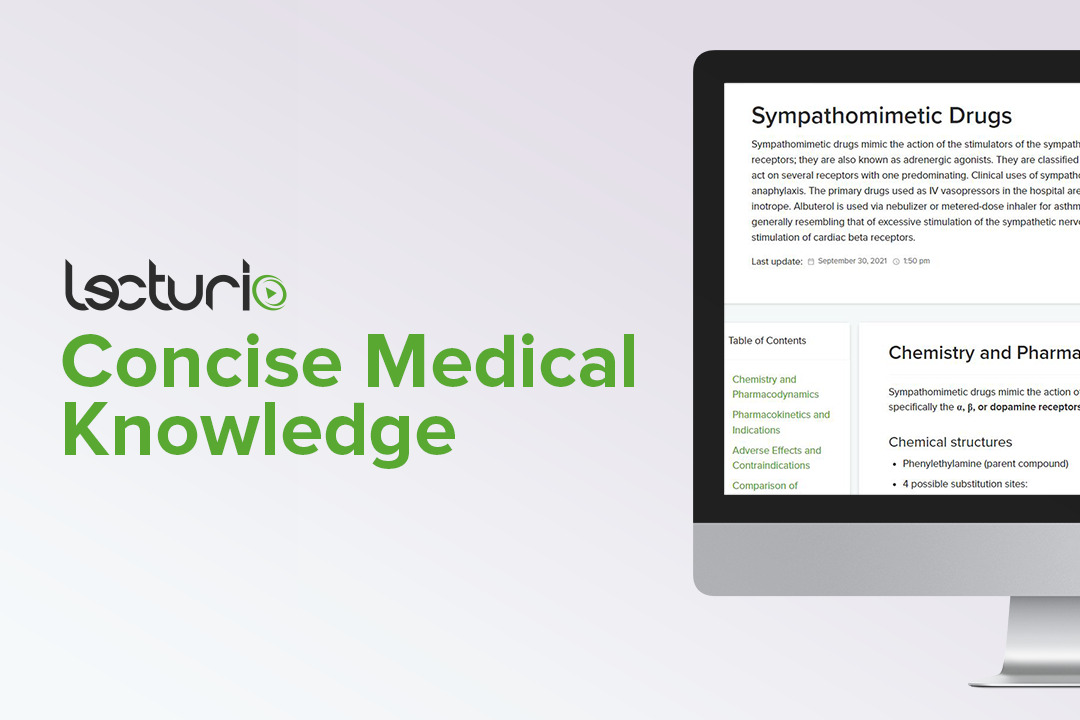Playlist
Show Playlist
Hide Playlist
Sympathomimetic Effects
-
Slides Sympathomimetic Effects.pdf
-
Reference List Pharmacology.pdf
-
Download Lecture Overview
00:01 Okay. Let's go back to the eye. So what are the effects of drugs that are sympathomimetics on the eye? Well, first of all, you get contraction of the radial or dilator muscles, so you open up the iris. 00:17 That's called mydriasis. Now, accommodation is rarely affected in this situation. 00:22 But just remember that when you're running away from that saber-toothed tiger as a caveman or a cavewoman, you want to be able to see in the dark. That's a sympathomimetic effect, and so sympathomimetic drugs are going to cause pupillary dilatation. 00:39 Nonselective alpha agonists reduce intraocular pressure, and that's because you increase drainage of aqueous humour. 00:49 Alpha 2 selective agonist also reduce intraocular pressure, and that's because there's reduced synthesis of aqueous humour, and examples are listed here. Okay, now I'm confused. What is going on? And I know you're saying this "You just finished telling me that those other drugs, the cholinomimetics do the same thing. 01:15 and the beta blocker do the same thing. Well, how come all of these drugs reduce intraocular pressure?" Well, let's just go over it really quickly. Beta blockers reduce secretion from the ciliary epithelium. 01:28 Cholinomimetics contract the ciliary muscles and they open up trabecular. So, normally the trabecular are closed, but as the ciliary muscle contracts, they open up like this. And what you end up having is increased outflow of the aqueous humour, and therefore you reduced pressure. Alpha agonists increased outflow through the veins. 01:55 So, in the veins in the back of the eye and inside the retina, you have veins that are sealed up with tight gap junctions, and when the veins relax because of the alpha agonists, the gap junction open up, fluid from the eye can get absorbed into the vein, and so the vein carries away the extra pressure. 02:16 Alpha 2 agonists decrease aqueous secretion from other parts of the eye. 02:21 Prostaglandins like latanoprost increase aqueous outflow through another mechanism which we won't get into, and you don't need to know right now. And carbonic anhydrase inhibitors decrease aqueous secretion due to decreased bicarbonate ion. So, remember you need bicarbonate ion to make aqueous humour or aqueous fluid. 02:46 Therefore, if you have less bicarbonate because of the carbonic anhydrase inhibitor, you'll have less ability to make more fluid. So, all of these different drug classes reduce intraocular pressure. 03:02 So, when you're going through your exam, just remember that pretty much all of the drugs that are eyedrops are going to reduce intraocular pressure, and the only drug that increase intraocular pressure are generally systemic drugs. 03:20 Let's move on. Sympathomimetic effects on the heart are usually mediated through drugs like isoproterenol and epinephrine. 03:28 We actually use these drugs a lot in the intensive care unit. They cause sinoatrial node excitation. 03:35 They increase the rate of the heart, and we remember call that positive chronotropy. 03:40 They also increase contractile force in the atria. So you have positive inotropy in the atria. 03:46 In the AV node, you increased conduction velocity. Do you remember what that's called? That's positive dromotropy. 03:54 Increased refractory period as well. With the ventricles, you increased the contractile force of the ventricles, we of course call that positive inotropy or more strength. 04:06 With norepinephrine, it is a positive inotrope as well. 04:10 Norepinephrine is primarily used in the treatment of severe hypotension, such as occurs in different types of shock, including cardiogenic shock. 04:19 Isoproterenol is a nonselective agent. And one of the effects that you will see in the vasculature is that it will reduce arteriolar tone, but it also increases cardiac output. So, the net effect is generally a reduced blood pressure and an increased heart rate. So sometimes, when a patient has poor forward heart function, we will give isopro. 04:45 Okay, dopamine. Dopamine is a complicated drug, but we still use it in the intensive care unit as one of the inotropes. 04:52 At low doses, dopamine primarily affects dopaminergic receptors. These receptors are spread throughout the body, including in the renal vascular beds, which are crucial for kidney function. Activation of these receptors leads to dilation of these blood vessels, improving blood flow to the kidneys. 05:10 This is particularly beneficial in clinical settings where increasing renal blood flow is desired. 05:17 At intermediate doses, dopamine starts activating the beta-adrenergic receptors, particularly those in the myocardium, resulting in an increase in heart rate and cardiac output. At high doses, dopamine begins to activate alpha-adrenergic receptors, leading to increased peripheral resistance and renal vasoconstriction. This increases blood pressure but this effect can be a double-edged sword, as it can reduce kidney blood flow due to the constriction of renal vessels. 05:48 While dopamine can improve cardiac output in heart failure, and renal perfusion may in some cases be maintained at higher doses, recent studies have cast doubt on the long-held belief that dopamine can effectively preserve renal function in heart failure patients there are no studies showing that it benefits renal function in these patients. 06:07 There are other places where we use sympathomimetic drugs. In chronic orthostatic hypotension. 06:14 There are a lot of patients out there that when they stand up, they drop their pressures through their boots. 06:20 Now, I have several patients over the age of 100, and many patients over the age of 90, and I often see this in my very elderly patients. They just drop their pressure when they stand up, but when they're sitting or lying, their pressures were normal. The first step in managing orthostatic hypotension or OH is to recognize the symptoms and measure the blood pressure drop, ensuring it meets the criteria for OH, which is a reduction of systolic BP bt ≥20 mm Hg and/or reduction in diastolic BP of ≥10 mm Hg within 2-5 minutes of standing. Next, review the patient's current medications and discontinue any that might exacerbate the condition, such as diuretics or alpha-blockers. 07:10 If symptoms persist, we move on to nonpharmacologic measures. These include increasing salt and water intake to boost blood volume, making lifestyle modifications such as slow positional changes, and implementing physical supports like compression stockings or abdominal binders. These interventions often alleviate the symptoms without the need for drugs. 07:31 When nonpharmacologic measures are insufficient, we consider pharmacologic treatment. 07:36 If symptoms are partially improved with increased salt and water intake but not fully managed, we initiate treatment with Fludrocortisone, a steroid that helps increase blood volume and pressure. 07:47 If there's still an inadequate response, we then look at plasma norepinephrine levels to guide our next steps. If levels are below 220 pg/mL, we consider using Droxidopa or Midodrine, which act to increase blood pressure by different mechanisms. Droxidopa is a prodrug that is converted in the body to norepinephrine. Midodrine is a prodrug that is converted in the body to its active form, desglymidodrine, which is an alpha-1 adrenergic receptor agonist that causes vasoconstriction. If plasma norepinephrine levels are levels are higher than 220 pg/mL, we might opt for Norepinephrine transporter inhibitors, or NET inhibitors, which work by blocking the norepinephrine transporter, which is responsible for the reuptake of norepinephrine from the synaptic cleft back into the presynaptic neuron. By inhibiting this reuptake, NET inhibitors increase the amount of norepinephrine available in the synaptic cleft, thereby enhancing norepinephrine's effects on the cardiovascular system, including increased vasoconstriction and blood pressure. Atomoxetine, is an example of a NET inhibitor, primarily used for attention deficit hyperactivity disorder (ADHD) but also found to be effective in treating orthostatic hypotension. 09:13 Okay. What are the sympathomimetic effects on the brain? Now, remember that catecholamines generally don't cross the blood brain barrier. Why? Because they are polar molecules. 09:24 However, cocaine and amphetamines do cross the blood brain barrier. There is a mild increased in alertness and reduction of fatigue at very low doses of these drugs. At toxic levels, particularly with cocaine, you have anorexia, aggressiveness, some paranoia, and sometimes seizures. 09:44 Amphetamines may also be used in central nervous system sympathomimetic activity to treat narcolepsy. 09:52 Methylphenidate is a drug that we use in atention deficit hyperactivity disorder, that also is quite useful and it is a sympathomimetic. 10:04 What about the lung? What can we do with the lung? Sympathomimetic effects in the lung relaxes in response to beta 2 agonists. So, isoproterenol, albuterol, salbutamol, formoterol, all of these drugs, the one I want you to remember in particular is salbutamol which is also known as ventalin. 10:23 Now, sometimes I'll use epinephrine, that's usually in anaphylatic shock, and we often will give epinephrine subQ, so you'll probably aware of EpiPens that kids will carry, in the allergy kids, particularly if they're allergic to peanuts. 10:43 What are the sympathomimetic effects in the gut? So, the smooth muscle will relax its muscle. 10:49 And this is both an alpha and a beta mediated event. Now, alpha 2 receptors may also decrease the amount of salt and water secretion in the gut as well. 11:03 What about the urinary tract? Now, this is something that I've always found difficult to understand, so let's just think about running away from our saber-toothed tiger. If you're running away from a saber-toothed tiger, do you really want to be peeing? Well, the answer is no. You don't want that saber-toothed tiger to pick up your scent, from your urine, right? So, it makes sense that the system is going to shut down the excretion of urine. 11:30 So, the detrusor muscle will relax, the trigone will contract, the sphincter will contract. 11:39 What are its effects on the female genital tract? Beta 2 agonists can cause uterine relaxation. 11:46 This will cause a secondary tachycardia in the mother. In general, we don't want to use this drug unless it's absolutely necessary, but we do use terbutaline in premature labour (correct spelling: labor) to try and surpress (correct spelling: suppress) contraction. 11:58 Terbutaline is a second-line drug, only used if the first-line drugs, like nifedipine, do not work.
About the Lecture
The lecture Sympathomimetic Effects by Pravin Shukle, MD is from the course ANS - Pharmacology.
Included Quiz Questions
What most likely decreases with isoproterenol administration?
- Refractory period of the atrioventricular node
- Positive chronotropic effect
- Positive ventricular inotropic effect
- Positive dromotropic effect
- Positive atrial inotropic effect
What drug class reduces intraocular pressure by reducing aqueous production?
- Beta blockers
- Cholinomimetics
- Non-selective alpha-adrenergic agonists
- Prostaglandins
- All of the answers reduce aqueous production.
What drug might improve symptoms of urinary incontinence?
- Ephedrine
- Tamsulosin
- Valium
- Neostigmine
- Bethanechol
Which receptors are primarily stimulated during tocolysis caused by terbutaline?
- Beta-2 adrenergic receptors
- Beta-1 adrenergic receptor
- Alpha-2 adrenergic receptor
- Dopamine receptor
- Alpha-1 adrenergic receptor
Customer reviews
5,0 of 5 stars
| 5 Stars |
|
1 |
| 4 Stars |
|
0 |
| 3 Stars |
|
0 |
| 2 Stars |
|
0 |
| 1 Star |
|
0 |
This was most helpful and extremely interesting. Hats off for explaining such a tough topic in an exceptionally innovative and engrossing manner.







